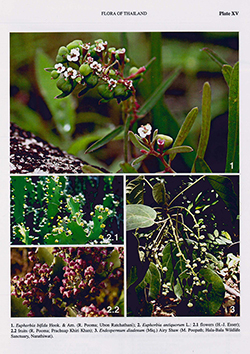e-Flora of Thailand
Volume 8 > Part 1 > Year 2005 > Page 269 > Euphorbiaceae > Euphorbia
3. Euphorbia bifida Hook. & Arn.wfo-0000960989
Bot. Beechey Voy. 5: 213. 1837; Boiss. in DC., Prodr. 15(2): 25. 1862; J.S.Ma & Z.Y.Wu, Acta Bot. Yunnan, 15: 117. 1991; J.S.Ma, Fl. Reipubl. Popularis Sin. 44(3): 42, pl. 8 fig. 1–4. 1997; Esser & Chayamarit, Harvard Papers Bot. 6: 261. 2001.— Chamaesyce bifida (Hook. & Arn.) T.Kurosawa, Acta Phytotax. Geobot. 51: 212. 2001. Plate XV: 1.
Accepted Name : This is currently accepted.
Synonyms & Citations :
Description : Perennial, many-stemmed, mostly erect, branched subshrub, up to ca 70 cm high often with a thick, woody rootstock (but sometimes without so). Glabrous to distinctly pubescent on vegetative parts. Indumentum consisting of brownish-pale hairs, 0.2–1 mm long, weakly erect. Stipules 0.7–1.5 mm long, narrowly triangular, united, apically to deeply bifid, otherwise quite entire. Leaves: petioles 1–2 mm long; opposite, often only apically; blades narrowly oblong-elliptic to lanceolate (rarely ovate or obovate), 12–35 by 3–7 mm, chartaceous, base oblique with one side cordate, the other side obtuse-rounded, margin entire or completely or only apically serrate, apex mucronate, papillate-hyalin and appearing grey-silvery below, venation very indistinct, slightly triplinerved, with ca 8–10 pairs of side veins. Cyathia 3–10 (or numerous) grouped together in terminal and axillary, dichotomous clusters to 3 cm in diam., often on leafless shoots, glabrous to slightly pubescent, each branching subtended by small leaf-like to linear bracts; peduncle 2–4 mm long; involucre ca 1 mm long, sometimes apically pubescent; glands 4, 0.5 by 0.7 mm, redish-brown, with orbiculate-spathulate, large and corolla like, pink to white, entire appendages 1–1.5 by 1.5–2 mm; ovary with stigmas of 0.8–1 mm, apically bifid for ca half of their length. Fruits glabrous, with a pedicel of 1–1.5 mm; schizocarp 2–2.25 by 2–2.5 mm, sulcate, sometimes with unequal locules. Seeds 1.4 by 0.8 mm, ovate, light brown and whitish, not papillate but with numerous, distinct circular depressions, ecarunculate.
Thailand : NORTHERN: Chiang Mai (Doi Kum, Doi Saket, Pa Yo Forest Centre), Phayao (Chiang Muan), Lampang (Doi Khun Tan, Mae Luang, Palat, Chae Hom), Tak (Ban Tak), Phitsanulok (Ban Chang); NORTH-EASTERN: Phetchabun (Nam Nao), Nong Bua Lum Phu, Nakhon Phanom (Tha Uten); EASTERN: Chaiyaphum; SOUTH-WESTERN: Kanchanaburi (Khao Thong), Prachuap Khiri Khan (Sam Roi Yot); SOUTH-EASTERN: Chon Buri (Si Racha, Ko Si Chang); PENINSULAR: Chumphon (Ko Tao), Songkhla (Padang Besar).
Distribution : Japan (Ryukyus), Taiwan, S China (types of Euphorbia bifida and E. vachellii), Indo-Chine (types of E. coudercii, E. coudercii forma glaberrima, E. harmandii), Malesia (Java – type of E. backeri, Lesser Sunda Islands, Maluku, the Philippines), Solomon Islands, up to N Australia and the New Hebrides, to be expected in Burma.
Ecology : In open grassy ground, dry dipterocarp forests, open deciduous dipterocarp-oak forests, at margin of teak forests, usually exposed and often flowering in leafless forests; on sandy or rocky, often thin soil, granite or limestone bedrock; sea level to ca 850 m alt. Flowering and fruiting: the whole year through.
Vernacular : Ya kae hak lueang (ยาแก้ฮากเหลือง)(Lampang); muk bia (มูกเบี้ย)(Nakhon Phanom); muk-noi (มูกน้อย)(So-Nakhon Phanom).
Notes: This species is extremely variable in vegetative characters, like leaf size and margin and pubescence. Radcliffe-Smith (1972) even noted a close resemblance to African species that should be evaluated in more detail. The record of Euphorbia linearifolia was based on the misdetermination of a single collection (Hosseus 709), which is a good match of E. bifida.

